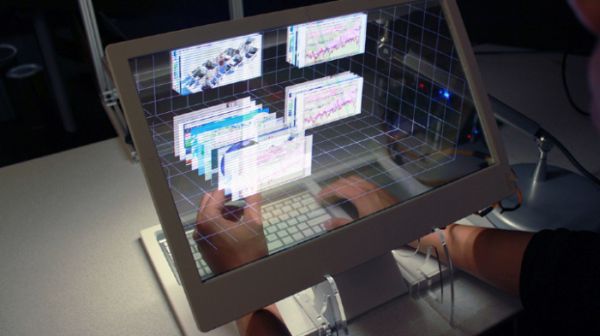NEWS ON Thursday, 31 October 2013
NANOTECHNOLOGY
Thursday, 31 October 2013
5 Incredible Ways Technology Is Making Life Easier
5 Incredible Ways Technology Is Making Life Easier
While we can sometimes feel like throwing our computers out
the window, ultimately technology gives us a wealth of opportunities to have more comfortable lives.
Technology
is intended to make our lives easier. While we can sometimes feel like
throwing our computers out the window, or going on vacation just to get
away from all the buzzing, beeping, and being too connected, ultimately
technology gives us a wealth of opportunities to have more comfortable
lives - even with lower carbon footprints.
Check out 5 incredible ways technology is helping us breathe easier and live smarter.
Telemedicine
Using
telecommunications to improve medicine has become invaluable to doctors
and patients in rural and underprivileged areas. Doctors from any
location can communicate with the most highly skilled of their
colleagues at major hospitals to get consultations on patients,
improving the diagnosis and treatment of illnesses without requiring the
patients to travel. Telemedicine has been a huge boon for people from
post-quake Haiti to Argentina.
iPad and Tablet Devices
It is still up for debate how much of a game-changer tablet devices will
become, however it's clear that there are countless uses for it in
making our lives easier to dematerialize. Tablet devices can act as
books, magazines, gaming devices, netbooks for surfing the internet and
checking email, and so much more. It can potentially be an all-in-one
device for consumers - from getting news to monitoring your home's
energy use - as well as find a myriad of uses in places from school
classrooms to medical facilities to business boardrooms. While they also
have the potential to be a massive e-waste problem, if used well and
kept running for years, they could help us reduce energy consumption,
since they have a longer battery life than laptops and even some mobile
phones; and help us reduce our consumption, since they replace many
gadgets and other objects we might otherwise purchase.
Augmented Reality
Layering
data over our field of vision seems to be the next wave of technology
that helps us navigate our world, both literally - some apps are already
built that help us find our way to, and through, subway systems or
cycle in the right direction without holding a map - and figuratively,
with apps that could help us find the green businesses nearby.
Supplementing our vision with a whole lot of information - even to the
point of wearing contacts with augmented reality display capabilities -
can lead to an infinite number of potential uses, though it could
equally lead to information overload. It'll be interesting to watch how
augmented reality finds its niches.
Smart Cities
the innovations around transitioning our urban infrastructure into
intelligent, interconnected grids is vastly important for reducing our
consumption of resources. New technologies for the smart grid, for smart
water management, for smart cars and urban transportation are all
guiding us towards making more happen with less. We are developing
everything from dashboards for monitoring our energy and water use both
in homes and business structures, to algorithms for more intelligent
data centers, and fully embracing the idea of if you can't measure it,
you can't manage it. We're finally getting technology to effectively
manage our resources
Product Service Systems
Okay, so this is actually an ancient notion. But today's technology is
making it easier than ever to turn a product into a service. This means
our hardware stores are transformed into tool libraries, our car
dealerships into car-share programs, even the stuff in our closet into a
neighborhood rental system. Most of this is thanks to the Internet and
social networking sites connecting people to each other and the stuff we
can share. Why buy when you can borrow? Technology - including smart
phone apps - are making it easier than ever to save money and the planet
by swapping instead of shopping
Wednesday, 30 October 2013
Graphene Supercapacitors to aid Renewable Energy
Graphene Supercapacitors to aid Renewable Energy

Graphene, a one atom thick layer of graphite has properties of high thermal and electrical conductivity, and is also strong and flexible.
These properties make graphene an interesting proposition for clean technology such as solar cell production however; researchers from Monash University, based in Australia, have developed a method of combining graphene, utilizing its properties, with supercapacitor technology.
Supercapacitors consist of highly porous carbon combined with a liquid electrolyte, which transports an electrical charge. The main advantages of supercapacitors consist of a near unlimited lifespan and quick re-charge capabilities.
Drawbacks consist of a low energy density, the ratio of energy storage to volume, of about five to eight watt-hours per liter meaning that they have to be constantly charged and are typically large.

Graphene supercapacitors could really benefit renewable energy due to its high energy density.
Enter Professor Dan Li and his team, at the department of materials
engineering, who have created a graphene supercapacitor with an energy
density of 60-watt hours per liter, 12 times higher than some standard
supercapacitors."It has long been a challenge to make SCs smaller, lighter and compact to meet the increasingly demanding needs of many commercial uses." Professor Li said.
Using liquid electrolytes and a graphene gel film, the team were able to control the spacing between graphene sheets on the sub-nanometer scale enabling the liquid electrolytes to maintain minute space between graphene sheets as well as conduct electricity which maximizes energy density.
Professor Li further states, "We have created a macroscopic graphene material that is a step beyond what has been achieved previously. It is almost at the stage of moving from the lab to commercial development."

Graphene gel is made up from the conversion of graphite into highly porous, mechanically robust conductive films.
To ensure a cost-effective production that could be scaled for
industrial use, this material was created using a similar methodology to
that of traditional papermaking.The advantages of supercapacitors go hand in hand with renewable energy and utilizing with innovations such as electric vehicles, the drawbacks coming from the low energy density. Combining this with graphene, it can improve the density twelve times over meaning that this can be utilized in the commercial and industrial sector in the future.
Microsoft’s see through screen defies all existing technology norms
Microsoft’s see through screen defies all existing technology norms
Microsoft has always surprised us with the advanced technology and futuristic gadgets. Their uniqueness sets in when they really bring about some happening models right out of their kitty. As of now, researchers Jinha Lee and Cati Boulanger working in Microsoft have come up with a transparent computer screen, all set to amaze you with yet another Microsoft creation.
Their approach towards the modernization of the gadget has made use of a Samsung OLED screen, bringing forth a revolution in the way we perform our day to day functions. Their designer computer screen has put everything in motion, but not in the usual way we perform our duties.
Normally, when you look at a basic computer’s design, the keyboard and mouse come first, followed by the computer screen. However, the whole scenario has been reversed, bringing with it a re-customized design in its wake. The screen has been made transparent, while the keyboard has been fitted behind the screen. The user needs to deal with 2D and 3D images, giving them a larger than life approach. The screen’s preview is adjustable, letting you adjust your line of view accordingly. The software can be adjusted on the screen, letting you pick and choose with the flick of a hand. The images get accustomed to your hand movements, letting you decide which one to choose from.
In conclusion, all that can be said is that the wicked See through 3D display from Microsoft is going to get a lot rolling apart from just the user’s eyeballs. It will definitely take some time to get used to this new concept. But once fully launched, it will be a show stealer for sure.















































0 comments:
Post a Comment